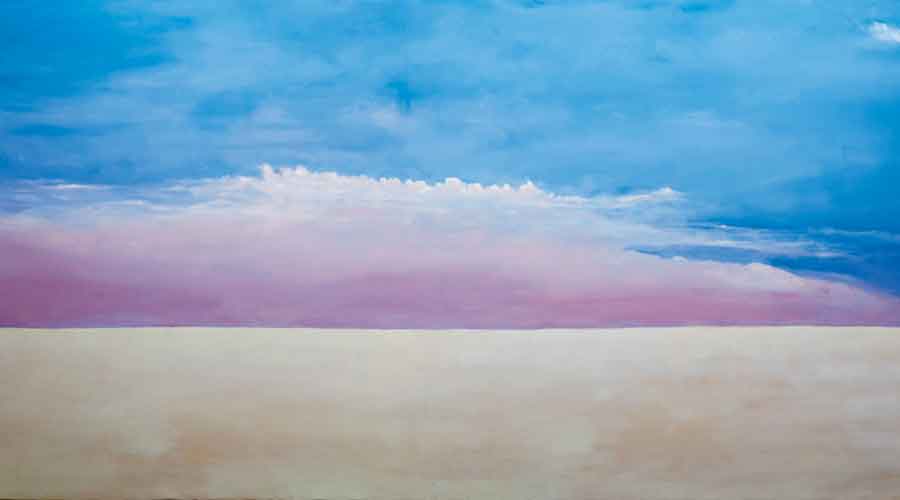The Bangladeshi artist, Ayesha Sultana, had moved, almost 12 years ago, from figuration to a geometry of rigour and optical guile that skitters through self-referential permutations. Now, surprisingly, she returns to a representational idiom, inspired by Nature. Yet, she had never been tempted into painting landscapes before because her focus was liminal rather than panoramic as she explored the interstices between materiality and void, pause and motion, the repetitiveness of patterns and the teasingly open-ended configurations it yields.
Therefore, Sultana’s detour in her recent suite, which was on display at Experimenter (Ballygunge Place) till April 10, is significant. It replaces the architecture of terse lines and rectangles, cubes, dashes and triangles that largely marked the abstract autonomy of her language with a new vision of transcendental romanticism. It must be noted, however, that enquiry isn’t abandoned: subsumed in an infectious epiphany, it distils from Nature the dynamism of colours, shapes and movements that unfold through the transient poetry of the sky, of water bodies and of foliage.
That is why the series cannot be categorized as naturescapes per se, which usually package Nature into separate objective forms to frame views distanced from the viewer. To Sultana, Nature opens up an immersive experience. What happens, therefore, is the convergence of contrary pulls as representational imagery is alchemized into fluid rhythms of colour and shape.
What marked Sultana’s work over a period of seven years since it was first seen in Calcutta was a flinty, cryptic leanness that, nevertheless, seemed to be lit by her complicit winks. As though its ambiguous brevity was a mind sport for viewers left to figure its resonance in terms of their own experience and references. That pared-down reticence is still there, it still peels away inessentials to arrive at the core. Only this time it’s the bare bones of a new visual experience she examines: a plunge into Nature’s opulence. Hence the title, Bare Bones.
A mesmeric sequence of eight Rothkoesque canvases is the first example to cite. Together they play a muted symphony of tones that range from porous barely-there blue-greys that remind one of a dull day sky, through a sedate morning to a shift to the glowing, contrapuntal oranges of dusk to the contemplative blues — cerulean to inky — that descend on them. If label them you must, colour field painting would come closest to describing this set. But unlike the latter, there’s a distinct reference to the sky, symbolizing the obliteration of the human identity in an expansive, uplifting pantheism. This is because of the vast, freely-breathing spaces the graded tones embody; no hard edges box them in, no thick strokes flatten them, no frames curb the ellipses that suggest a continuum beyond the seen.
The sky is given to moods. Its clouds glower darkly or scamper in diaphanous, elusive formations, or turn into incandescent banks set on fire at sunset in a theatre of vertiginous spaces. Water bodies run a gently tripping rhythm through a ripple of strokes in varied shades of turquoise. Palm fronds, structured like blinds, sway with feminine grace. A straggly filigree of leaves is caught against the night sky. Everyday moments of beatitude, thoughtlessly ignored.
Elsewhere, a multi-storeyed building stands as a hollow carcass, one wall ripped away. By what? Bombing? Demolition balls in the age of frenzied makeovers? Or an earthquake? Because Sultana does seem to address the skirmish between environmental health and civilizational demands. Decaying brickwork steps reclaimed by green shoots; a grey wall fringed with a grass verge; the canopy of a tree entangled with overhead cables. Has living precariously with Covid-19 sharpened human sensitivity to Nature’s rights?











